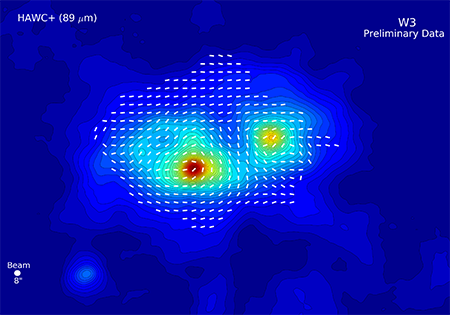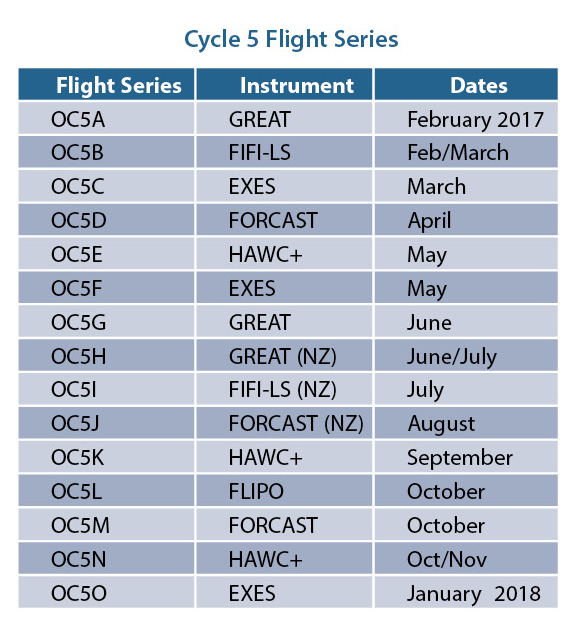1. First Light HAWC+ Far-infrared Imaging and Polarization Map
2. SOFIA Science Community Newsletter Volume 2 (January 2017)
3. Eric Becklin and Ian McLean receive 2017 AAS Prizes
4. SOFIA Science Conferences
5. USRA awarded SMO contract renewal / grant funding continuing
6. SOFIA archival data available through ADAP
1. First Light HAWC+ Far-infrared Imaging and Polarization Map

Above: HAWC+ team (PI: Darren Dowell, JPL-Caltech) presents HAWC+ far-IR (89 μm) image and polarization map of the W3 star-forming region. In this image, the E vector directions are shown overlain on a total intensity image. For clarity, only one-quarter of the polarization measurements are shown and the line segments are set to a fixed length.
A new far-infrared camera and polarimeter, the High-resolution Airborne Wideband Camera-Plus (HAWC+), adds unique and powerful capabilities to SOFIA’s instrument complement. HAWC+ is designed to operate in five broad wavelength bands at 53, 63, 89, 154 and 214 μm.
The HAWC+ polarization measurements distinguish cloud cold and warm dust components. A first-light far-IR image and polarization map at 89 μm of the star-forming region W3 (above) shows structure in the far-IR polarization. Each line segment represents the orientation of polarization caused by elongated dust grains aligned with the magnetic field in the cloud.
The principal investigator of HAWC+ is Dr. Darren Dowell at NASA's Jet Propulsion Laboratory in Pasadena, California. The HAWC+ proposal was selected in 2013 via NASA’s SOFIA second-generation instrument call for proposals. Dowell and his team took over development of the instrument from the team led by Dr. Al Harper of the University of Chicago Yerkes Observatory, who was the principal P.I. of the original first-generation HAWC instrument. (Harper remains on the HAWC+ team.) HAWC+ has significant improvements over HAWC, including a larger field of view (improved by a factor of four) and the addition of polarimetric capabilities. HAWC+ took only three years from the selection announcement in 2013 to the first light images in 2016. This demonstrates the potential for quick turn-around time in developing more instruments for SOFIA.
HAWC+ can help astronomers study grain alignment by magnetic fields and other mechanisms in protostellar envelopes, pre-stellar cores, giant molecular clouds, material behind shock waves, and in the general ISM.
SOFIA “Teletalk” presentation by HAWC+ P.I. Darren Dowell (01/18/17)
Please note that the 63 μm channel is not currently useable; corrective actions are being discussed. Also, date of availability of pipeline-processed data from the November 2016 and April 2017 HAWC+ observing campaigns is TBD. Please direct questions and comments to the SOFIA Science Center help desk: "sofia_help {at} sofia.usra.edu".
2. SOFIA Science Community Newsletter Volume 2, issued in January 2017
SOFIA Newsletter Volume 2 was printed and issued to the scientific community in January 2017 and distributed at the winter 2017 AAS meeting in Grapevine, Texas. Highlights of the newsletter are summarized below; the full newsletter is available here .
Included in the newsletter:
1) Observatory Director’s message from Harold Yorke
2) German Perspective / Farewell message from Hans Zinnecker
3) Science highlights by W. T. Reach, Deputy Director, Science
4) Science Operations and Outreach by B-G Andersson, Associate Director for Science Operations
5) Public Outreach by Coral Clark: More than 100 Teachers onboard SOFIA AAA
6) SOFIA Cycle 5 schedule (table below)

3. Eric Becklin and Ian McLean Receive 2017 AAS Prizes
We are pleased to note that Eric Becklin is the recipient of the American Astronomical Society's 2017 Henry Norris Russell Lectureship. This prize was awarded "for lifetime preeminence in astronomical research for his leadership role over the last half century in turning infrared astronomy into a fundamental tool for understanding the Universe." Becklin will give his Henry Norris Russell Lecture during the 231st AAS meeting (January 2018, National Harbor, Maryland). Becklin is a senior scientist with USRA, SOFIA’s chief scientific advisor and observatory director emeritus, as well as professor emeritus of physics and astronomy at UCLA.
Dr. Becklin has pioneered discoveries using infrared observations in a wide range of contexts, including the galactic center, star-forming regions, evolved stars, brown dwarfs, exoplanets, and the obscured nuclei of other galaxies, with telescopes on the ground, in the stratosphere, and in space.
Dr. Ian S. McLean, professor of physics and astronomy at UCLA and P.I. of SOFIA’s FLITECAM instrument, has been named the 2017 recipient of the American Astronomical Society’s Joseph Weber Award for Astronomical Instrumentation "for more than 30 years at the forefront of the development of advanced infrared sensor arrays and for his leadership in the design, construction, and deployment of innovative infrared instruments that have had widespread and fundamental scientific impact across a broad community of astronomers."
More information can be found here .
4. SOFIA Science Conferences
The SOFIA project’s long-term plan of organizing conferences in alternate years in Germany and in the United States is proceeding well. The second of these meetings, “The Local Truth: Star-Formation and Feedback in the SOFIA Era – Celebrating 50 Years of Airborne Astronomy” took place during October 2016 at the Asilomar Conference Grounds in Northern California. Program and presentations can be found here.
The most recent meeting in the series, “Spectroscopy with SOFIA; New Results and Future Opportunities” was held in Germany at Schloss Ringberg, March 5-8, 2017. A detailed meeting agenda plus some of the presentations can be found by going to the meeting website then to the “Timetable” menu item. Each talk is a calendar item; folder symbols are links to the presentations.
We expect to start planning soon for a 2018 U.S.-based meeting.
5. USRA awarded SMO contract renewal/grant funding continuing
The contract for managing SOFIA Science Mission Operations (SMO) was re-competed over this past year. The selection was announced by NASA and we are happy to note that USRA was selected to continue as the SMO contractor. The formal transition from the old to the new contract will take place over the coming summer. With this situation clarified, the formal status of the General Observer ("Data Analysis") grants are also clarified, such that the next renewal for current Cycle 3-5 grants will now extend to the intended duration (nominally two years).
6. SOFIA archival data available through ADAP
For the community to take advantage of the growing SOFIA science archive, we ask you to please remember that NASA's Astrophysics Data Analysis Program (ADAP) can provide funding for such work. The next proposal deadline is May 16. Note that, for ADAP, a Notice of Intent (NOI) is encouraged but not required. For more information, please visit here and then go to Appendix D.2: Astrophysics Data Analysis